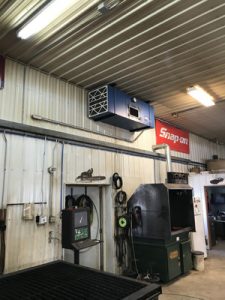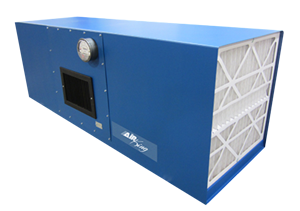Air Filtration In The Welding Shop
Potential Health Issues Associated With Welding
Smoke and fumes generated from the welding process are made up of a complex mixture of various components that include sub micron particulate matter and gasses. It can also include shielding gasses which are used in welding processes. Potential health issues can be the result. As an example, the welding of stainless steel can give off chromium and nickel which are components of stainless steel. Welding stainless steel converts the chromium in the stainless to hexavalent chrome. Hex chrome fumes are toxic. Other materials can result in potential health issues associated with the lungs, throat, kidneys, and nervous system to name a few. Smoke and fumes can also cause irritation to the nose, throat and eyes. More serious issues can include different forms of cancers. For health reasons, careful consideration should be given to proper air filtration in the welding environment and the air filtration systems in the welding shop should be well maintained with filters being changed on a regular basis.
Air Filtration for Welding

Source Capture Collector
Broadly speaking, there are two forms of air filtration, source capture and ambient capture. Source capture is the pick-up of the contaminated air at the point of generation. Anytime we can source capture, especially when the contamination source is near the breathing zone, it is in our best interests to do so. Once that contaminated air escapes into the surrounding environment, it becomes more problematical, less efficient and more costly to deal with and it is at this point that we must turn to ambient capture. Source capture typically involves the use of portable filtration systems with articulated pick-up arms. These work well when the welding work envelope area is about 36” x 36” or less. The downside of source capture is that the operator must keep the pickup hood relatively close to the work area. The pickup hood should be placed such that it draws the welding fumes away from the welders breathing zone and into the smoke collector.
Ambient collection involves the placement of multiple units thorough out the shop. These units are designed and set up specifically for ambient air cleaning. They are typically hung from the ceiling or walls and are manufactured with an intake grill and exhaust grill. Some configurations may have more than one of each.

Ambient Air Cleaner in A Welding Shop
The number of air cleaners required for a welding shop is determined based on its size. The size of the shop is calculated in cubic feet. The number of air cleaners required becomes a mathematical calculation and is the desired number of air changes per hour required to achieve the desired air cleanliness level. That level is attained when the number of air changes per hour is great enough to exceed the amount of contamination being generated.
As previously mentioned, anytime you can capture at the source you are better off doing so. However, source capture depends on the operator positioning the pickup hood correctly.

Air King Model M-30
If the operator has to move the hood repeatedly because of a large work envelope they may not move it at all; thus rendering the source capture ineffective.
Ambient collection on the other hand eliminates this need and it also eliminates any ductwork, the articulating arm and pickup hood. Ambient air cleaning does not however remove the contamination from the welders breathing zone. While the ambient air in the shop will be cleaner, the air in the work zone may not be at an acceptable cleanliness level. In the end, the best approach depending on the shop and the layout may well be a combination of both methods.
Air Filters For Welding
Air filters used in the air cleaners are progressively staged. Adequate pre-filtration should be incorporated in the unit configuration to remove larger particulate contaminate. This results in the added benefit of extending the life of the more costly main or final air filter. The main filters should be at the MERV 15 level.
In a source capture unit, pre-filtration is usually accomplished by a 4” aluminum mesh pre filter. This is designed to remove the larger particles from the airstream. It also has the added benefit of acting as a spark arrester. In the ambient air collector, the pre-filter would normally be a 4” pleated Merv 8 filter. The main filter in a source capture unit is usually a Merv 15 which is designed to remove more than 95% of particulate .030 — 1.0 µm in size. The application, the material being welded and the byproducts produced should dictate the retention level of the filter. Other retention levels are available, but it is best to use a Merv 15. As the filter becomes clogged, the air flow will decrease and a gauge will indicate when the filter needs replacement. The filter, while it does represent an ongoing cost, should be replaced promptly. To delay in the replacement is counter productive to the clean air objective.
Maintaining healthy air quality in the work environment is in the best interests of all. In a healthy environment people tend to be more productive and the quality of the air we breathe can have a significant impact on health and longevity.
